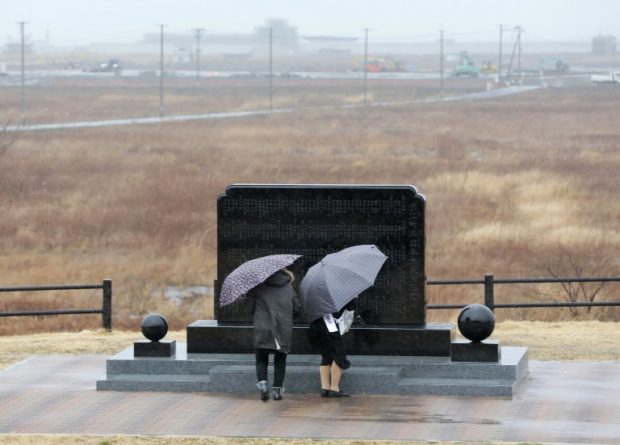Japan marks tsunami, nuclear tragedy eight years on

People pray in front of a memorial monument in Namie, Fukushima Prefecture on March 11, 2019 on the eighth anniversary of the 2011 tsunami disaster. AFP
TOKYO, Japan — With flowers, silent prayers and tearful tributes, Japan Monday marked the eighth anniversary of a crippling earthquake, tsunami and nuclear disaster that devastated its northeastern coast and left some 18,500 people dead or missing.
Prime Minister Shinzo Abe, lawmakers and family members who lost their loved ones in the disaster bowed their heads in prayer at a ceremony in Tokyo at 2:46 pm (0546 GMT) — the exact moment the magnitude-9.0 quake struck.
“We can’t help but feel sorrow when we think about the suffering of those who lost beloved family members, relatives and friends,” Abe said.
Eight years on, he said reconstruction was making “steady” progress but vowed to continue government support to tens of thousands still struggling in uncomfortable living conditions.
In a constant drizzle, residents in tsunami-hit coastal towns also laid bouquets and bowed their heads as they remembered the moment the waves hit, devastating entire communities in an instant.
Article continues after this advertisementJapan’s ageing Emperor Akihito and Empress Michiko did not attend the ceremony this year, but were represented by their second son Prince Akishino and his wife Princess Kiko.
Article continues after this advertisementIn addition to causing widespread death and destruction, the killer tsunami also swamped the emergency power supply at the Fukushima Daiichi power plant.
This sent its reactors into meltdown as cooling systems failed, sparking the worst global nuclear disaster since Chernobyl in 1986.
According to the National Police Agency, some 18,430 people died or were missing as a result of the earthquake and tsunami.
In addition, more than 3,700 people — most of them from Fukushima — died from illness or suicide linked to the aftermath of the tragedy, according to government data, while more than 51,000 still remain displaced.
Although no-one is officially recorded as having died as a result of radiation from the accident, dozens of reactors across Japan were switched off in the aftermath.
The government has lifted evacuation orders for much of the region affected by the meltdown, except for some no-go zones with high radiation levels.
Authorities are encouraging evacuees to return, but the population in the Fukushima prefecture has more than halved from some two million in the pre-disaster period.
In 97.3 percent of the region “it is possible to lead a normal life,” said reconstruction minister Hiromichi Watanabe — a claim disputed by NGOs such as Greenpeace.
Around 12,000 people who fled their homes for fear of radiation have filed dozens of lawsuits against the government and the Tokyo Electric Power Company (TEPCO), the operator of the stricken nuclear plant.
Roughly one in two Japanese voters think the reconstruction of the disaster-hit area “is not making progress” despite the rebuilding of infrastructure such as railways and houses for people who lost their homes in the disaster.
According to the poll, 72.9 percent of voters think the Japanese government should halt its policy of exporting nuclear technology, compared to 14.7 percent who support the policy. /ee